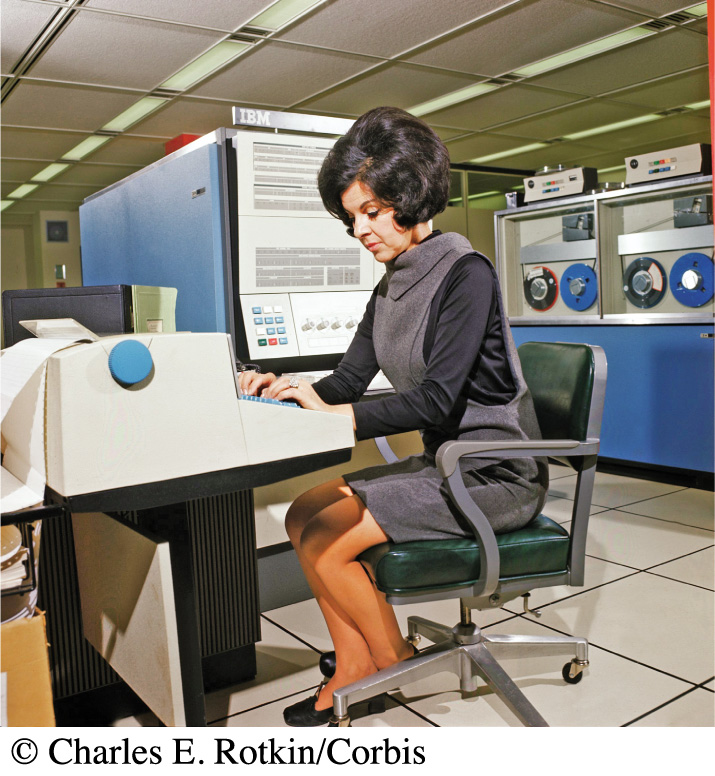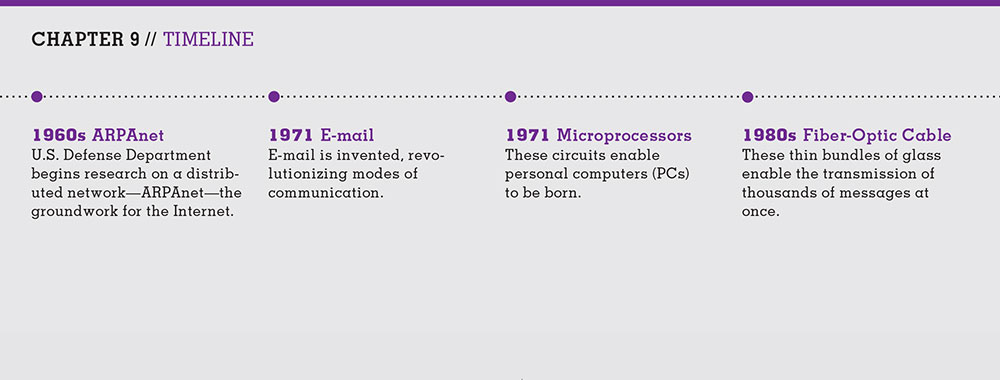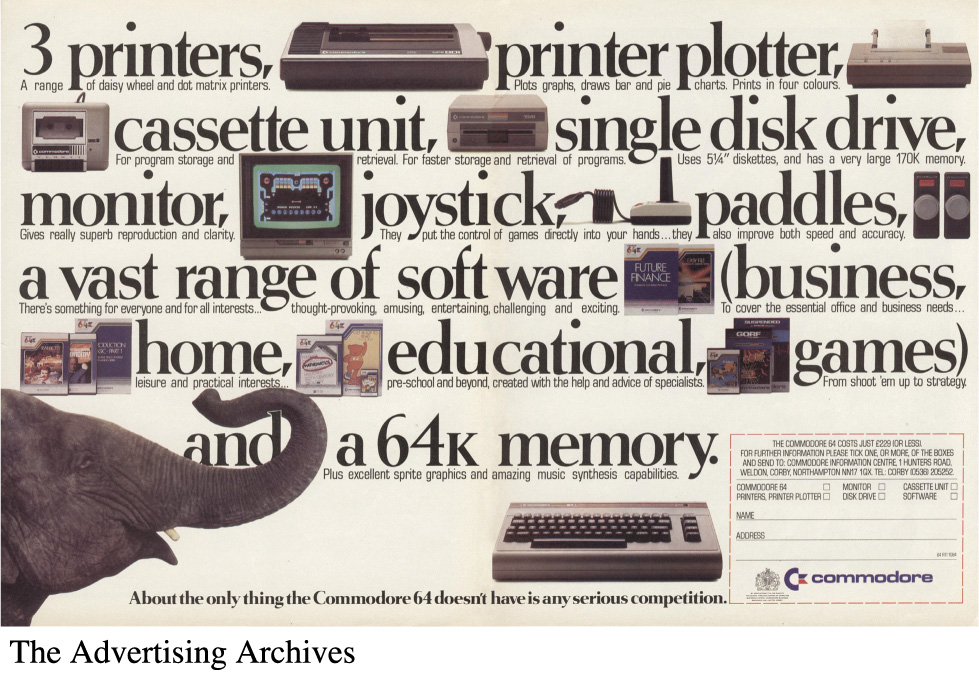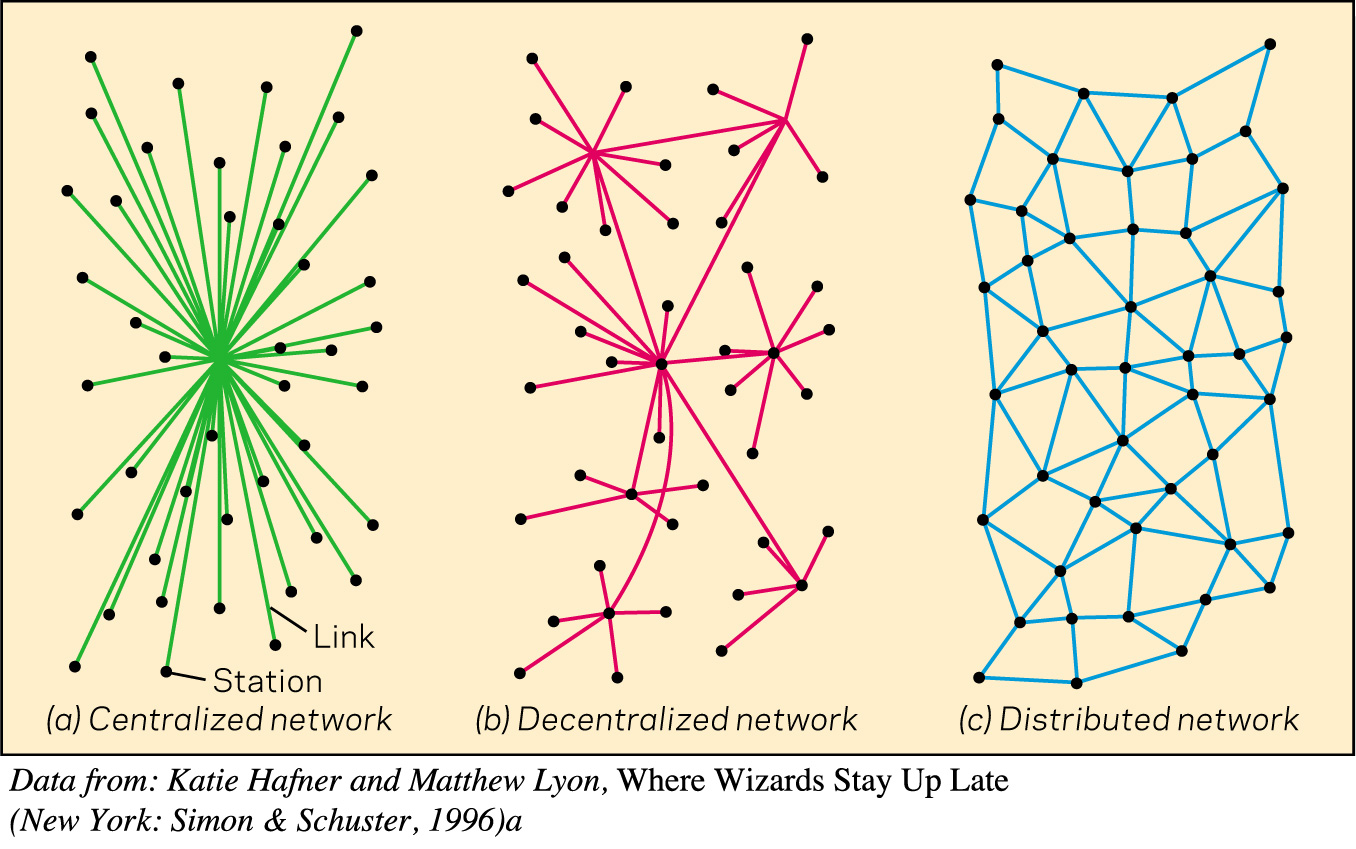The Early History of the Internet
After World War II, the United States entered the Cold War against the Soviet Union, pitting the two great powers in a decades-long battle of military and economic superiority. The space race was a symbolic part of the Cold War, and when the Soviet spacecraft Sputnik became the first to orbit the earth in 1957, the United States was shocked at being beaten. The event ushered in a new era of U.S. government spending on technological, scientific, and military developments. The United States would later make its first successful rocket launch with Explorer in 1958, but perhaps more important to our world today was the creation that same year of a new U.S. Defense Department research agency that would eventually develop the Internet. In the decades that followed, new technology like microprocessors and fiber-optic cable increased the commercial viability of data transmission, paving the way for the Internet to become a mass medium.

macmillanhighered.com/mediaessentials3e
Use LearningCurve to review concepts from this chapter.

Military Functions, Civic Roots
Created in 1958, the U.S. Defense Department’s Advanced Research Projects Agency (ARPA) assembled a team of computer scientists around the country to develop and test technological innovations. Computers were relatively new at this time, and there were only a few expensive mainframe computers, each big enough to fill an entire room. Yet the scientists working on ARPA projects wanted access to these computers. A solution to the problem was proposed: First, share computer-processing time by creating a wired network system in which users from multiple locations could log onto a computer whenever they needed it. Second, to prevent logjams in data communication, the network used a system called packet switching, which broke down messages into smaller pieces to easily route through the network, and reassembled them on the other end. This system provided multiple paths linking computers to one another, thereby allowing communication to continue if one of the paths got clogged or disrupted—much like the national highway system supported by President Dwight Eisenhower. This computer network became the original Internet—called ARPAnet and nicknamed the Net—and it enabled military and academic researchers to communicate on a distributed network system (see Figure 9.1).
CHAPTER 9 // TIMELINE
1960s ARPAnet
U.S. Defense Department begins research on a distributed network—ARPAnet—the groundwork for the Internet.
1971 E-mail
E-mail is invented, revolutionizing modes of communication.
1971 Microprocessors
These circuits enable personal computers (PCs) to be born.
1980s Fiber-Optic Cable
These thin bundles of glass enable the transmission of thousands of messages at once.
1980s Hypertext
This data-linking feature enables users to link one Web page to another, creating the World Wide Web.
1985 AOL
The company is launched, becoming the most successful ISP over the next decade.
1986 NSF
The National Science Foundation sponsors a high-speed communications network, connecting computers across the country.
1993 Web Browsers
The Internet becomes navigable and user-friendly.
1999 Blogging
Blogging software is created, helping to popularize this form of communication.
2000 Cookies
Information profiles on users enable data mining to flourish.
2000s Broadband
Users switch from dial-up to broadband with cable modem or DSL connections.
2001 Instant Messaging
Instant messaging becomes the fastest-growing area of the Internet.
2002 Social Networking
Friendster is founded as the first major social networking site, inspiring MySpace (2003) and Facebook (2004).
2007 Smartphones
The iPhone is introduced, creating a trend toward Internet-accessing smartphones.
2010 iPad
Apple releases a multipurpose touchscreen tablet.

Click on the timeline above to see the full, expanded version.
297

With only a few large, powerful research computers in the country, many computer scientists were suddenly able to access massive (for that time) amounts of computer power. The first Net messages ever were sent in 1969, when ARPAnet connections linked four universities: the University of California–Los Angeles, the University of California–Santa Barbara, Stanford, and the University of Utah. By 1970, another terminal was in place in Cambridge, Massachusetts, at the computer research firm Bolt, Beranek and Newman (BBN), and by late 1971, there were twenty-three Internet hosts at university and government research centers across the United States. This same year, Ray Tomlinson of BBN came up with an essential innovation to help researchers communicate—e-mail—and decided to use the “@” sign to separate the user’s name from the computer name, a convention that has been used ever since.
298

During this development stage, the Internet (still called ARPAnet at this time) was used primarily by universities, government research labs, and corporations involved in computer software and other high-tech products. These users exchanged e-mail and posted information on computer bulletin boards—sites that listed information about particular topics, such as health, technology, or employment services.
299
The Net Widens
From the early 1970s to the late 1980s, the Internet moved from the development stage to the entrepreneurial stage, in which it became a marketable medium. The first signal of the Net’s imminent marketability came in 1971 with the introduction of microprocessors—miniature circuits that could process and store electronic signals. This led to the introduction of the first personal computers (PCs), which were smaller, cheaper, and more powerful than the bulky systems that had occupied entire floors of buildings during the 1960s. In 1986, the National Science Foundation sponsored the development of a high-speed communications network (NSFNET) and established supercomputer centers on the campuses of Princeton, the University of Illinois, the University of California–San Diego, and Cornell, and a fifth in Pittsburgh—jointly operated by Carnegie Mellon, the University of Pittsburgh, and Westinghouse—which were designed to speed up access to research data and encourage private investment in the Net. This government investment triggered a dramatic rise in Internet use and opened the door to additional commercial possibilities.
Also in the mid-1980s, fiber-optic cable, thin bundles of glass capable of transmitting thousands of messages simultaneously (via laser light), became the standard for conveying communication data speedily—making the commercial use of computers even more viable than before. Today, thanks to this increased speed, the amount of information that digital technology can transport is nearly limitless.
In 1990, ARPAnet officially ended; and in 1991, the NSF opened its network fully to commercial use. By this time, a growing community of researchers, computer programmers, amateur hackers, and commercial interests had already tapped into the Internet. These tens of thousands of participants in the network became the initial audience for the Internet’s emergence as a mass medium.